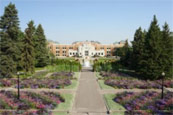| Editorial
Dear readers,
 We
are happy to present the new edition of the Canadian Botanical Conservation
Network Newsletter, a newly combined effort with the Canadian Botanical
Gardens Educator’s Network Newsletter. This collaboration
will offer a forum for exchange wherein the various issues regarding
the conservation of plant biodiversity are addressed (scientific,
applied and public awareness issues). This new approach will also
enable us to work together to ensure the long-term continuity of
this relationship. We
are happy to present the new edition of the Canadian Botanical Conservation
Network Newsletter, a newly combined effort with the Canadian Botanical
Gardens Educator’s Network Newsletter. This collaboration
will offer a forum for exchange wherein the various issues regarding
the conservation of plant biodiversity are addressed (scientific,
applied and public awareness issues). This new approach will also
enable us to work together to ensure the long-term continuity of
this relationship.
In order to highlight the International Day for Biological Diversity,
May 22nd, this edition of the Newsletter is devoted to the topic
of Biological Diversity and Climate Change. As such, several articles
address this increasingly important and topical issue.
This Newsletter is above all your Newsletter: we trust that you
will feel free to share your viewpoints on the topics that matter
to you, in any way you deem fit. We’ve adopted a new format
which is more reader-friendly as it relates to the length of articles.
We strongly encourage you to share your ideas, comments, topics
of interest, and articles with us.
You will notice that this edition is entirely bilingual: all the
articles are presented in French and English. For budgetary reasons,
it will unfortunately be impossible for us to maintain this level
of bilingualism in the following editions, and we will have to limit
translations to the summary of articles. As such, we would invite
you to submit your articles in both official languages, if at all
possible.
With particular thanks to our collaborators for their contributions
for this edition of the Newsletter,
Happy reading!
Yann Vergriete
1. A note from CBCN Executive
Director, David Galbraith, Royal Botanical Gardens
 I'd
like to welcome all CBCN Newsletter and Canadian Botanic Gardens
Education Newsletter readers to our first joint issue! Starting
with this issue, CBCN Newsletter, which has been published in various
forms since 1996, will be merged and updated by the addition of
the newsletter of the Canadian Botanic Gardens Educators Network
as established under Investing in Nature: A Partnership for Plants
in Canada.>
more I'd
like to welcome all CBCN Newsletter and Canadian Botanic Gardens
Education Newsletter readers to our first joint issue! Starting
with this issue, CBCN Newsletter, which has been published in various
forms since 1996, will be merged and updated by the addition of
the newsletter of the Canadian Botanic Gardens Educators Network
as established under Investing in Nature: A Partnership for Plants
in Canada.>
more
2. Message from Ahmed Djoghlaf, Executive
Secretary to the Convention on Biological Diversity on the occasion
of the International Day for Biological Diversity, May 22nd 2007
 Climate
change is real. The UN’s lead scientific authority on climate
change, the Intergovernmental Panel on Climate Change, in its most
recent report, prepared by 2500 experts from 130 countries, has
indicated that the concentration of CO2 in the earth’s atmosphere
is of a level not seen for some 650,000 years. The cause: human
activities. >
more Climate
change is real. The UN’s lead scientific authority on climate
change, the Intergovernmental Panel on Climate Change, in its most
recent report, prepared by 2500 experts from 130 countries, has
indicated that the concentration of CO2 in the earth’s atmosphere
is of a level not seen for some 650,000 years. The cause: human
activities. >
more
3. Plant conservation in a changing world,
Suzanne Sharrock, BGCI
 The
world’s climate is presently changing more rapidly than at
any time in human history. Such climatic changes are intimately
connected with plants, which harness the energy of the sun through
photosynthesis and maintain ecosystems for all life on earth. According
to recent estimates, more than 100,000 plant species are currently
threatened with extinction. However, the rate of extinction is expected
to increase further as global temperatures continue to rise, and
as many as half of the estimated 400,000 plant species in existence
today may be under threat. >
more The
world’s climate is presently changing more rapidly than at
any time in human history. Such climatic changes are intimately
connected with plants, which harness the energy of the sun through
photosynthesis and maintain ecosystems for all life on earth. According
to recent estimates, more than 100,000 plant species are currently
threatened with extinction. However, the rate of extinction is expected
to increase further as global temperatures continue to rise, and
as many as half of the estimated 400,000 plant species in existence
today may be under threat. >
more
4. Preparing to Launch the North American
Botanic Gardens Conservation Strategy, David
Galbraith, Royal Botanical Gardens
 There
has been an almost continuous effort since 2000 to link the missions
and programs of botanical gardens around the world with international
movements like the UN’s Convention on Biological Diversity,
and the more recent Global Strategy for Plant Conservation. The
newest publication in this effort is being published this summer
and is called the North American Botanic Gardens Conservation Strategy.
>
more There
has been an almost continuous effort since 2000 to link the missions
and programs of botanical gardens around the world with international
movements like the UN’s Convention on Biological Diversity,
and the more recent Global Strategy for Plant Conservation. The
newest publication in this effort is being published this summer
and is called the North American Botanic Gardens Conservation Strategy.
>
more
5. Biodiversity, climate change, and cultural
diversity, Alain Cuerrier, Jardin Botanique de Montréal
 Most
people, researchers and laymen alike, view biodiversity in terms
of biology without giving due consideration to First Nations and
their cultural components. More and more publications and studies
acknowledge the importance of putting culture in the biodiversity
equation. But the merging of scientific and traditional knowledge
is still far from equal. The balance shifts inexorably towards science
which then reduces tradition to a mere quotation of good will. In
the Convention on Biodiversity (CBD), cultural diversity has also
been established as an important role (see Art. 8j). Not only are
rare, endangered or vulnerable species to be protected but so are
medicinal species and, moreover, species used in ritual or those
who have simply a local, social importance. In order to protect
any taxon, it is essential to make use of all available data. >
more Most
people, researchers and laymen alike, view biodiversity in terms
of biology without giving due consideration to First Nations and
their cultural components. More and more publications and studies
acknowledge the importance of putting culture in the biodiversity
equation. But the merging of scientific and traditional knowledge
is still far from equal. The balance shifts inexorably towards science
which then reduces tradition to a mere quotation of good will. In
the Convention on Biodiversity (CBD), cultural diversity has also
been established as an important role (see Art. 8j). Not only are
rare, endangered or vulnerable species to be protected but so are
medicinal species and, moreover, species used in ritual or those
who have simply a local, social importance. In order to protect
any taxon, it is essential to make use of all available data. >
more
Mr. Tivi Etok
Photo: The Montréal Botanical Garden
6. The urgent need for biodiversity information,
Tom Hammond, IUCN
 Environmental
degradation and species loss continue to accelerate. Around the
world, conservation and scientific organizations are working against
time to close critical knowledge gaps in order to conserve biodiversity
and the Earth’s life support systems. Investment and development
decisions are often taken with an incomplete picture of potential
impacts on biodiversity. While solutions may be found to reverse
these trends, this will only be possible with comprehensive data,
information and knowledge on the conservation and sustainable use
of biodiversity. >
more Environmental
degradation and species loss continue to accelerate. Around the
world, conservation and scientific organizations are working against
time to close critical knowledge gaps in order to conserve biodiversity
and the Earth’s life support systems. Investment and development
decisions are often taken with an incomplete picture of potential
impacts on biodiversity. While solutions may be found to reverse
these trends, this will only be possible with comprehensive data,
information and knowledge on the conservation and sustainable use
of biodiversity. >
more
7. Adapting to a Changing World, Krista
Blackborow & Dianne Watkins, Biodiversity Convention Office
of Environment Canada
 In keeping with this
year’s International Biodiversity Day theme, the April 16,
2007 meeting of the Federal-Provincial-Territorial Biodiversity
Working Group in Winnipeg, Manitoba included a one-day symposium
on Biodiversity and Climate Change Adaptation. >
more In keeping with this
year’s International Biodiversity Day theme, the April 16,
2007 meeting of the Federal-Provincial-Territorial Biodiversity
Working Group in Winnipeg, Manitoba included a one-day symposium
on Biodiversity and Climate Change Adaptation. >
more
Photo: Biodiversity Convention Office,
Environment Canada
8. The Canadian University
Biodiversity Consortium and a new biodiversity center at the Montréal
Botanical Garden, Anne Bruneau, Institut de recherche
en biologie végétale, Université de Montréal
 The
Canadian University Biodiversity Consortium is a partnership headed
by the Université de Montréal, in collaboration with
the universities of British Columbia, Alberta, Saskatchewan, Manitoba,
Toronto, Guelph, York, McGill, Laval, Acadia and Memorial, the Montreal
Botanical Garden, University of British Columbia Botanical Garden,
Devonian Botanical Garden, Harriet Irving Botanical Garden, Memorial
University Botanical Garden and the Royal Ontario Museum. The Consortium
was recently funded by the Canadian Foundation for Innovation programme
to a total of 16 million dollars. This Consortium unites Canadian
researchers from multiple disciplines, renowned for their expertise
in a diversity of taxonomic groups, tools and approaches. >
more The
Canadian University Biodiversity Consortium is a partnership headed
by the Université de Montréal, in collaboration with
the universities of British Columbia, Alberta, Saskatchewan, Manitoba,
Toronto, Guelph, York, McGill, Laval, Acadia and Memorial, the Montreal
Botanical Garden, University of British Columbia Botanical Garden,
Devonian Botanical Garden, Harriet Irving Botanical Garden, Memorial
University Botanical Garden and the Royal Ontario Museum. The Consortium
was recently funded by the Canadian Foundation for Innovation programme
to a total of 16 million dollars. This Consortium unites Canadian
researchers from multiple disciplines, renowned for their expertise
in a diversity of taxonomic groups, tools and approaches. >
more
Anne Bruneau
Photo: The Montréal Botanical Garden
9. Stopping the Green Invasion! Memorial
University of Newfoundland Botanical Garden Takes Aim at Invasive
Alien Species, Costa Kasimos & Joy Barfoot, MUN Botanical
Garden
 If
you’ve ever driven onto one of the ferries leaving Newfoundland,
you’ve probably been pleasantly surprised by the complimentary
car wash…until you see that they only cleaned the bottom of
your car. This is but one of many programs across the country designed
to prevent the spread of invasive alien species; in this case the
Golden Nematode (a potato disease). Canada, as well as mostother
countries, has been forced to deal with the multi-billion dollar
problems associated with alien species. >
more If
you’ve ever driven onto one of the ferries leaving Newfoundland,
you’ve probably been pleasantly surprised by the complimentary
car wash…until you see that they only cleaned the bottom of
your car. This is but one of many programs across the country designed
to prevent the spread of invasive alien species; in this case the
Golden Nematode (a potato disease). Canada, as well as mostother
countries, has been forced to deal with the multi-billion dollar
problems associated with alien species. >
more
Centaurea nigra
Photo: MUN Botanical Garden
10. What’s Coming Up at CITES CoP
14, Adrianne Sinclair, CITES Scientific Advisor for Plant
Trade
 The
14th meeting of the Conference of the Parties (CoP) to CITES (Convention
on International Trade in Endangered Species) will take place from
June 3 to 15, 2007, in the Hague, Netherlands. The CoP meets every
three years to amend the list of species regulated under the Convention
in Appendices I and II. Species listed in Appendix I are endangered
because of international trade and those in Appendix II could become
endangered if trade is not regulated. >
more The
14th meeting of the Conference of the Parties (CoP) to CITES (Convention
on International Trade in Endangered Species) will take place from
June 3 to 15, 2007, in the Hague, Netherlands. The CoP meets every
three years to amend the list of species regulated under the Convention
in Appendices I and II. Species listed in Appendix I are endangered
because of international trade and those in Appendix II could become
endangered if trade is not regulated. >
more
11. Letter from Wuhan: A report on the
Third Global Botanic Gardens Congress, David Galbraith,
Royal Botanical Gardens
 Botanic
Gardens Conservation International, Wuhan Botanical Garden and the
Chinese Academy of Sciences organized a very exciting and productive
global congress for botanical gardens involved in conservation in
April, 2007. more Botanic
Gardens Conservation International, Wuhan Botanical Garden and the
Chinese Academy of Sciences organized a very exciting and productive
global congress for botanical gardens involved in conservation in
April, 2007. more
Congress delegates at the botanical garden
prior to the official meeting
Photo: David Galbraith
12. The Montréal Botanical Garden
Formally Reinforces its Commitment to Biodiversity Conservation,
and hosts a Wollemi Pine, Yann Vergriete, Institut de
recherche en biologie végétale, The Montréal
Botanical Garden
 The
City of Montreal recently signed an agreement bringing together
Muséums nature Montréal (the Montréal Botanical
Garden being one of its four constituents) with the Steering Committee
of the Consortium of Scientific Partners on Biodiversity (from the
international Convention on Biological Diversity). The sharing of
expertise and the development of knowledge as it relates to species
conservation will be highly beneficial. Moreover, with 1.7 million
annual visitors, the Museums offer an exceptional window from which
the Secretariat, as well as the issues connected to the loss of
biological diversity, can communicate their messages to a larger
audience. >
read more The
City of Montreal recently signed an agreement bringing together
Muséums nature Montréal (the Montréal Botanical
Garden being one of its four constituents) with the Steering Committee
of the Consortium of Scientific Partners on Biodiversity (from the
international Convention on Biological Diversity). The sharing of
expertise and the development of knowledge as it relates to species
conservation will be highly beneficial. Moreover, with 1.7 million
annual visitors, the Museums offer an exceptional window from which
the Secretariat, as well as the issues connected to the loss of
biological diversity, can communicate their messages to a larger
audience. >
read more
Photo: The Montréal Botanical
Garden
13. Meeting of the Canadian Pollination
Protection Initiative
 The
first meeting of the Canadian Pollinator Protection Initiative (CPPI)
was held in Ottawa from January 18-19, 2007 and was attended by
over 80 delegates from the bee industry, federal and provincial
governments, academia, museums, and environmental and agricultural
NGOs. This Initiative represents an expansion of the North American
Pollinator Protection Campaign (NAPPC) into Canada and serves to
link Canadian pollinator conservation with similar activities in
the USA and Mexico. >
more The
first meeting of the Canadian Pollinator Protection Initiative (CPPI)
was held in Ottawa from January 18-19, 2007 and was attended by
over 80 delegates from the bee industry, federal and provincial
governments, academia, museums, and environmental and agricultural
NGOs. This Initiative represents an expansion of the North American
Pollinator Protection Campaign (NAPPC) into Canada and serves to
link Canadian pollinator conservation with similar activities in
the USA and Mexico. >
more
From left to right: Laurie Adams ; Vernon
Thomas ; Peter Kevan ; Anne Breau ; Maria MacRae ; Elizabeth Kilvert
; Charles Caccia ; Steve Javorek ; David Suzuki (special guest).
Photo: Vicki Wojcik
14. Summer is around the corner. Make it
count! Join the Pollination Canada Buzz, Valérie
Girard, Seeds of Diversity Canada
 Seventy
percent of our food crops need insects for pollination. Most wild
plants, and small animals that eat seeds, could not survive without
them. Not only bees and butterflies; there are over 1000 species
of pollinating insects in Canada! Unfortunately, these beneficial
insects are under pressure from loss of habitat, loss of food sources,
disease, pesticides, and there is a growing concern about what impact
climate change will have on insect pollinators. As insect populations
are threatened, so are fruit and vegetable production, as well as
the wild ecosystems that depend on these pollinators. Information
is needed now, so that steps can be taken to preserve pollinator
populations. >
more Seventy
percent of our food crops need insects for pollination. Most wild
plants, and small animals that eat seeds, could not survive without
them. Not only bees and butterflies; there are over 1000 species
of pollinating insects in Canada! Unfortunately, these beneficial
insects are under pressure from loss of habitat, loss of food sources,
disease, pesticides, and there is a growing concern about what impact
climate change will have on insect pollinators. As insect populations
are threatened, so are fruit and vegetable production, as well as
the wild ecosystems that depend on these pollinators. Information
is needed now, so that steps can be taken to preserve pollinator
populations. >
more
15. First Sustainability Camp: a Success,
John Platenius, Tofino Botanical Gardens Foundation
 The
Tofino Botanical Gardens Foundation is pleased to announce that
its first Sustainability Camp was a resounding success. The goal
of Sustainability Camp is to increase youth knowledge and awareness
about global and local environmental issues, with the hope that
this increased awareness will help the next generation to develop
solutions and inspire action for positive environmental and social
change. >
more The
Tofino Botanical Gardens Foundation is pleased to announce that
its first Sustainability Camp was a resounding success. The goal
of Sustainability Camp is to increase youth knowledge and awareness
about global and local environmental issues, with the hope that
this increased awareness will help the next generation to develop
solutions and inspire action for positive environmental and social
change. >
more
Sustainability Camp students cleaning
up plastic debris on Long Beach as part of the curriculum's pollution
module.
Photo: Tofino Botanical Garden Foundation
16. Earth Day Celebration at UBC Botanical
Garden, Nadine Diner, UBC Botanical Garden
 The
UBC Botanical Garden is Canada's oldest continuously operating university
botanical garden, established in 1916 under the directorship of
John Davidson. The original mission of the garden was research into
the native flora of British Columbia. Since its inception, the mission
of the Garden has broadened. Our collections now include over 8000
different plants from around the globe in 12 000 separate accessions.
Many of these plants are wild-collected. Our mandate has also broadened
to include the use of our collections for the purposes of research,
conservation, teaching and public display. We find opportunities
in all Garden initiatives to connect these themes. >
more The
UBC Botanical Garden is Canada's oldest continuously operating university
botanical garden, established in 1916 under the directorship of
John Davidson. The original mission of the garden was research into
the native flora of British Columbia. Since its inception, the mission
of the Garden has broadened. Our collections now include over 8000
different plants from around the globe in 12 000 separate accessions.
Many of these plants are wild-collected. Our mandate has also broadened
to include the use of our collections for the purposes of research,
conservation, teaching and public display. We find opportunities
in all Garden initiatives to connect these themes. >
more
Photo: UBC Botanical Garden
| 
This message has been sent to you by A Partnership for Plants in
Canada (a project supported by BGCI-Canada and the Montréal
Botanical Garden) because you have expressed interest in receiving
information from us. If this message has been received in
error please notify yannvergriete@fastmail.fm. Click here
to avoid receiving future e-mails from us.
Yann Vergriete
Project coordinator
Institut de recherche en biologie végétale
The Montréal Botanical Garden
4101, rue Sherbrooke Est
Montréal (Québec) H1X 2B2
CANADA
www.bgci.org/canada
|
|

 We
are happy to present the new edition of the Canadian Botanical Conservation
Network Newsletter, a newly combined effort with the Canadian Botanical
Gardens Educator’s Network Newsletter. This collaboration
will offer a forum for exchange wherein the various issues regarding
the conservation of plant biodiversity are addressed (scientific,
applied and public awareness issues). This new approach will also
enable us to work together to ensure the long-term continuity of
this relationship.
We
are happy to present the new edition of the Canadian Botanical Conservation
Network Newsletter, a newly combined effort with the Canadian Botanical
Gardens Educator’s Network Newsletter. This collaboration
will offer a forum for exchange wherein the various issues regarding
the conservation of plant biodiversity are addressed (scientific,
applied and public awareness issues). This new approach will also
enable us to work together to ensure the long-term continuity of
this relationship.  I'd
like to welcome all CBCN Newsletter and Canadian Botanic Gardens
Education Newsletter readers to our first joint issue! Starting
with this issue, CBCN Newsletter, which has been published in various
forms since 1996, will be merged and updated by the addition of
the newsletter of the Canadian Botanic Gardens Educators Network
as established under Investing in Nature: A Partnership for Plants
in Canada.
I'd
like to welcome all CBCN Newsletter and Canadian Botanic Gardens
Education Newsletter readers to our first joint issue! Starting
with this issue, CBCN Newsletter, which has been published in various
forms since 1996, will be merged and updated by the addition of
the newsletter of the Canadian Botanic Gardens Educators Network
as established under Investing in Nature: A Partnership for Plants
in Canada. Climate
change is real. The UN’s lead scientific authority on climate
change, the Intergovernmental Panel on Climate Change, in its most
recent report, prepared by 2500 experts from 130 countries, has
indicated that the concentration of CO2 in the earth’s atmosphere
is of a level not seen for some 650,000 years. The cause: human
activities.
Climate
change is real. The UN’s lead scientific authority on climate
change, the Intergovernmental Panel on Climate Change, in its most
recent report, prepared by 2500 experts from 130 countries, has
indicated that the concentration of CO2 in the earth’s atmosphere
is of a level not seen for some 650,000 years. The cause: human
activities.  The
world’s climate is presently changing more rapidly than at
any time in human history. Such climatic changes are intimately
connected with plants, which harness the energy of the sun through
photosynthesis and maintain ecosystems for all life on earth. According
to recent estimates, more than 100,000 plant species are currently
threatened with extinction. However, the rate of extinction is expected
to increase further as global temperatures continue to rise, and
as many as half of the estimated 400,000 plant species in existence
today may be under threat.
The
world’s climate is presently changing more rapidly than at
any time in human history. Such climatic changes are intimately
connected with plants, which harness the energy of the sun through
photosynthesis and maintain ecosystems for all life on earth. According
to recent estimates, more than 100,000 plant species are currently
threatened with extinction. However, the rate of extinction is expected
to increase further as global temperatures continue to rise, and
as many as half of the estimated 400,000 plant species in existence
today may be under threat.  There
has been an almost continuous effort since 2000 to link the missions
and programs of botanical gardens around the world with international
movements like the UN’s Convention on Biological Diversity,
and the more recent Global Strategy for Plant Conservation. The
newest publication in this effort is being published this summer
and is called the North American Botanic Gardens Conservation Strategy.
There
has been an almost continuous effort since 2000 to link the missions
and programs of botanical gardens around the world with international
movements like the UN’s Convention on Biological Diversity,
and the more recent Global Strategy for Plant Conservation. The
newest publication in this effort is being published this summer
and is called the North American Botanic Gardens Conservation Strategy.
 Most
people, researchers and laymen alike, view biodiversity in terms
of biology without giving due consideration to First Nations and
their cultural components. More and more publications and studies
acknowledge the importance of putting culture in the biodiversity
equation. But the merging of scientific and traditional knowledge
is still far from equal. The balance shifts inexorably towards science
which then reduces tradition to a mere quotation of good will. In
the Convention on Biodiversity (CBD), cultural diversity has also
been established as an important role (see Art. 8j). Not only are
rare, endangered or vulnerable species to be protected but so are
medicinal species and, moreover, species used in ritual or those
who have simply a local, social importance. In order to protect
any taxon, it is essential to make use of all available data.
Most
people, researchers and laymen alike, view biodiversity in terms
of biology without giving due consideration to First Nations and
their cultural components. More and more publications and studies
acknowledge the importance of putting culture in the biodiversity
equation. But the merging of scientific and traditional knowledge
is still far from equal. The balance shifts inexorably towards science
which then reduces tradition to a mere quotation of good will. In
the Convention on Biodiversity (CBD), cultural diversity has also
been established as an important role (see Art. 8j). Not only are
rare, endangered or vulnerable species to be protected but so are
medicinal species and, moreover, species used in ritual or those
who have simply a local, social importance. In order to protect
any taxon, it is essential to make use of all available data.  Environmental
degradation and species loss continue to accelerate. Around the
world, conservation and scientific organizations are working against
time to close critical knowledge gaps in order to conserve biodiversity
and the Earth’s life support systems. Investment and development
decisions are often taken with an incomplete picture of potential
impacts on biodiversity. While solutions may be found to reverse
these trends, this will only be possible with comprehensive data,
information and knowledge on the conservation and sustainable use
of biodiversity.
Environmental
degradation and species loss continue to accelerate. Around the
world, conservation and scientific organizations are working against
time to close critical knowledge gaps in order to conserve biodiversity
and the Earth’s life support systems. Investment and development
decisions are often taken with an incomplete picture of potential
impacts on biodiversity. While solutions may be found to reverse
these trends, this will only be possible with comprehensive data,
information and knowledge on the conservation and sustainable use
of biodiversity.  In keeping with this
year’s International Biodiversity Day theme, the April 16,
2007 meeting of the Federal-Provincial-Territorial Biodiversity
Working Group in Winnipeg, Manitoba included a one-day symposium
on Biodiversity and Climate Change Adaptation.
In keeping with this
year’s International Biodiversity Day theme, the April 16,
2007 meeting of the Federal-Provincial-Territorial Biodiversity
Working Group in Winnipeg, Manitoba included a one-day symposium
on Biodiversity and Climate Change Adaptation.  The
Canadian University Biodiversity Consortium is a partnership headed
by the Université de Montréal, in collaboration with
the universities of British Columbia, Alberta, Saskatchewan, Manitoba,
Toronto, Guelph, York, McGill, Laval, Acadia and Memorial, the Montreal
Botanical Garden, University of British Columbia Botanical Garden,
Devonian Botanical Garden, Harriet Irving Botanical Garden, Memorial
University Botanical Garden and the Royal Ontario Museum. The Consortium
was recently funded by the Canadian Foundation for Innovation programme
to a total of 16 million dollars. This Consortium unites Canadian
researchers from multiple disciplines, renowned for their expertise
in a diversity of taxonomic groups, tools and approaches.
The
Canadian University Biodiversity Consortium is a partnership headed
by the Université de Montréal, in collaboration with
the universities of British Columbia, Alberta, Saskatchewan, Manitoba,
Toronto, Guelph, York, McGill, Laval, Acadia and Memorial, the Montreal
Botanical Garden, University of British Columbia Botanical Garden,
Devonian Botanical Garden, Harriet Irving Botanical Garden, Memorial
University Botanical Garden and the Royal Ontario Museum. The Consortium
was recently funded by the Canadian Foundation for Innovation programme
to a total of 16 million dollars. This Consortium unites Canadian
researchers from multiple disciplines, renowned for their expertise
in a diversity of taxonomic groups, tools and approaches.  If
you’ve ever driven onto one of the ferries leaving Newfoundland,
you’ve probably been pleasantly surprised by the complimentary
car wash…until you see that they only cleaned the bottom of
your car. This is but one of many programs across the country designed
to prevent the spread of invasive alien species; in this case the
Golden Nematode (a potato disease). Canada, as well as mostother
countries, has been forced to deal with the multi-billion dollar
problems associated with alien species.
If
you’ve ever driven onto one of the ferries leaving Newfoundland,
you’ve probably been pleasantly surprised by the complimentary
car wash…until you see that they only cleaned the bottom of
your car. This is but one of many programs across the country designed
to prevent the spread of invasive alien species; in this case the
Golden Nematode (a potato disease). Canada, as well as mostother
countries, has been forced to deal with the multi-billion dollar
problems associated with alien species.  The
14th meeting of the Conference of the Parties (CoP) to CITES (Convention
on International Trade in Endangered Species) will take place from
June 3 to 15, 2007, in the Hague, Netherlands. The CoP meets every
three years to amend the list of species regulated under the Convention
in Appendices I and II. Species listed in Appendix I are endangered
because of international trade and those in Appendix II could become
endangered if trade is not regulated.
The
14th meeting of the Conference of the Parties (CoP) to CITES (Convention
on International Trade in Endangered Species) will take place from
June 3 to 15, 2007, in the Hague, Netherlands. The CoP meets every
three years to amend the list of species regulated under the Convention
in Appendices I and II. Species listed in Appendix I are endangered
because of international trade and those in Appendix II could become
endangered if trade is not regulated.  Botanic
Gardens Conservation International, Wuhan Botanical Garden and the
Chinese Academy of Sciences organized a very exciting and productive
global congress for botanical gardens involved in conservation in
April, 2007.
Botanic
Gardens Conservation International, Wuhan Botanical Garden and the
Chinese Academy of Sciences organized a very exciting and productive
global congress for botanical gardens involved in conservation in
April, 2007.  The
City of Montreal recently signed an agreement bringing together
Muséums nature Montréal (the Montréal Botanical
Garden being one of its four constituents) with the Steering Committee
of the Consortium of Scientific Partners on Biodiversity (from the
international Convention on Biological Diversity). The sharing of
expertise and the development of knowledge as it relates to species
conservation will be highly beneficial. Moreover, with 1.7 million
annual visitors, the Museums offer an exceptional window from which
the Secretariat, as well as the issues connected to the loss of
biological diversity, can communicate their messages to a larger
audience.
The
City of Montreal recently signed an agreement bringing together
Muséums nature Montréal (the Montréal Botanical
Garden being one of its four constituents) with the Steering Committee
of the Consortium of Scientific Partners on Biodiversity (from the
international Convention on Biological Diversity). The sharing of
expertise and the development of knowledge as it relates to species
conservation will be highly beneficial. Moreover, with 1.7 million
annual visitors, the Museums offer an exceptional window from which
the Secretariat, as well as the issues connected to the loss of
biological diversity, can communicate their messages to a larger
audience.  The
first meeting of the Canadian Pollinator Protection Initiative (CPPI)
was held in Ottawa from January 18-19, 2007 and was attended by
over 80 delegates from the bee industry, federal and provincial
governments, academia, museums, and environmental and agricultural
NGOs. This Initiative represents an expansion of the North American
Pollinator Protection Campaign (NAPPC) into Canada and serves to
link Canadian pollinator conservation with similar activities in
the USA and Mexico.
The
first meeting of the Canadian Pollinator Protection Initiative (CPPI)
was held in Ottawa from January 18-19, 2007 and was attended by
over 80 delegates from the bee industry, federal and provincial
governments, academia, museums, and environmental and agricultural
NGOs. This Initiative represents an expansion of the North American
Pollinator Protection Campaign (NAPPC) into Canada and serves to
link Canadian pollinator conservation with similar activities in
the USA and Mexico.  The
Tofino Botanical Gardens Foundation is pleased to announce that
its first Sustainability Camp was a resounding success. The goal
of Sustainability Camp is to increase youth knowledge and awareness
about global and local environmental issues, with the hope that
this increased awareness will help the next generation to develop
solutions and inspire action for positive environmental and social
change.
The
Tofino Botanical Gardens Foundation is pleased to announce that
its first Sustainability Camp was a resounding success. The goal
of Sustainability Camp is to increase youth knowledge and awareness
about global and local environmental issues, with the hope that
this increased awareness will help the next generation to develop
solutions and inspire action for positive environmental and social
change.  The
UBC Botanical Garden is Canada's oldest continuously operating university
botanical garden, established in 1916 under the directorship of
John Davidson. The original mission of the garden was research into
the native flora of British Columbia. Since its inception, the mission
of the Garden has broadened. Our collections now include over 8000
different plants from around the globe in 12 000 separate accessions.
Many of these plants are wild-collected. Our mandate has also broadened
to include the use of our collections for the purposes of research,
conservation, teaching and public display. We find opportunities
in all Garden initiatives to connect these themes.
The
UBC Botanical Garden is Canada's oldest continuously operating university
botanical garden, established in 1916 under the directorship of
John Davidson. The original mission of the garden was research into
the native flora of British Columbia. Since its inception, the mission
of the Garden has broadened. Our collections now include over 8000
different plants from around the globe in 12 000 separate accessions.
Many of these plants are wild-collected. Our mandate has also broadened
to include the use of our collections for the purposes of research,
conservation, teaching and public display. We find opportunities
in all Garden initiatives to connect these themes. 